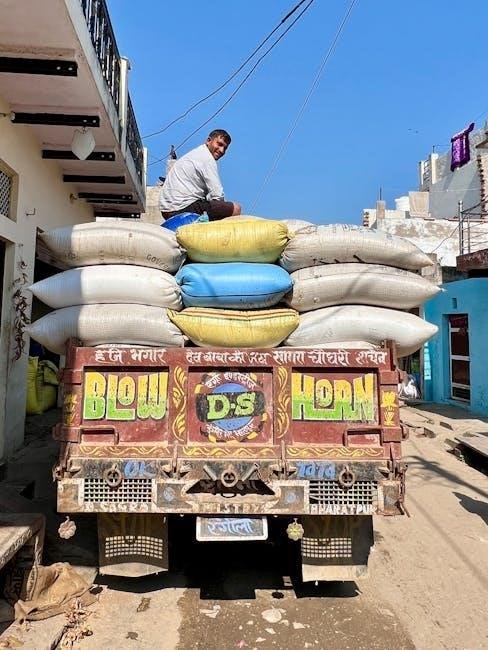The Ansul R-102 Restaurant Fire Suppression System is an automatic, pre-engineered solution designed to protect commercial kitchen areas, including hoods, ducts, and plenums, using wet chemical agents․
Overview of the Ansul R-102 System
The Ansul R-102 System is a pre-engineered, automatic fire suppression solution designed for commercial kitchen environments․ It is UL 300 listed and provides advanced protection for cooking equipment, hoods, ducts, and plenums․ The system uses wet chemical agents to suppress fires quickly and effectively․ Its compact design allows for flexibility in installation, making it suitable for various kitchen layouts․ The R-102 system is known for its reliability, ease of maintenance, and compliance with fire safety regulations, ensuring optimal protection in high-risk cooking areas․
Importance of Fire Suppression in Commercial Kitchens
Commercial kitchens are high-risk environments due to heat, grease, and open flames, making fire suppression systems like the Ansul R-102 essential․ These systems prevent small fires from escalating into costly disasters, protecting equipment, staff, and customers․ They also ensure compliance with fire safety regulations and minimize business interruptions․ A reliable fire suppression system is critical for safeguarding lives, reducing property damage, and maintaining operational continuity in busy kitchen settings․

System Description and Design
The Ansul R-102 is an automatic, pre-engineered fire suppression system designed for commercial kitchens, utilizing wet chemical agents to extinguish fires in hoods, ducts, and cooking equipment․
Key Components of the Ansul R-102 System
The Ansul R-102 System includes a regulated release assembly, wet chemical storage tank, nitrogen cartridge, piping network, fusible links, and nozzles․ The regulated release assembly controls the discharge of the wet chemical agent, while the storage tank holds the suppression agent․ The nitrogen cartridge propels the agent through the piping to the nozzles, which are strategically placed to cover protected areas․ Fusible links activate the system when exposed to high temperatures, ensuring rapid response during a fire event․
How the Ansul R-102 System Works
The Ansul R-102 System activates automatically when fusible links detect high temperatures, releasing a wet chemical agent to suppress fires․ The system can also be activated manually via a pull station or remote control․ Upon activation, the nitrogen cartridge propels the agent through the piping network to strategically placed nozzles, which discharge the chemical to cover protected areas, such as commercial kitchen hoods, ducts, and cooking equipment․ This rapid response ensures effective fire suppression and minimizes potential damage․

Installation and Setup
The Ansul R-102 System requires a systematic installation process, adhering to UL standards, involving the regulated release assembly, storage tank, and nozzle placement for optimal fire protection․
Step-by-Step Installation Guide
The Ansul R-102 installation involves several key steps․ First, plan the system layout to ensure proper coverage of the protected area․ Install the storage tank, regulated release assembly, and nozzles according to the design specifications․ Connect the piping system, ensuring all fittings are secure and leak-free․ Install fusible links and wiring for the control panel․ Finally, test the system to ensure proper activation and functionality, adhering to UL 300 standards for compliance․ A certified technician must inspect the system post-installation․
Design and Configuration Considerations
The Ansul R-102 system must be designed according to UL 300 standards, ensuring proper coverage for commercial kitchen hazards․ The configuration should account for the layout of cooking equipment, hoods, and ducts․ Nozzles must be strategically placed to ensure effective agent distribution․ The system’s piping and storage tank should be sized appropriately for the protected area․ Flexibility in design allows customization to meet specific kitchen requirements, ensuring optimal fire protection while maintaining operational efficiency․ Always adhere to the installation manual guidelines for reliable performance․
Maintenance and Inspection
Regular inspections and maintenance are crucial for the Ansul R-102 system․ Check nozzles, pressure, and fusible links․ Follow UL guidelines and manufacturer recommendations for optimal performance and compliance․
Regular Maintenance Requirements
The Ansul R-102 system requires regular checks to ensure reliability․ Inspect nozzles, pressure gauges, and fusible links monthly․ Annually, service the wet chemical storage tank and recharge cylinders if discharged․ Follow the UL 300 guidelines and consult the Design, Installation, Recharge, and Maintenance Manual for detailed procedures․ Proper maintenance ensures the system’s effectiveness in suppressing fires and protects your kitchen from potential hazards․ Schedule professional inspections annually to comply with safety standards․
Inspection Checklist for Optimal Performance
A thorough inspection checklist ensures the Ansul R-102 system operates effectively․ Inspect nozzles for blockages, verify pressure gauges are within range, and check fusible links for integrity․ Ensure the control panel displays no alarms, and all piping is securely connected․ Review the maintenance manual for specific guidelines․ Test remote actuation mechanisms and ensure all components are free from damage․ Conduct monthly visual inspections and annual professional evaluations to maintain compliance and readiness․ This checklist ensures your system is always prepared to respond to fire threats․

Troubleshooting and Repair
The Ansul R-102 system requires identifying common issues like nozzle blockages, system leaks, or faulty fusible links․ Refer to the maintenance manual for diagnostic steps and repair solutions․
Common Issues and Solutions
The Ansul R-102 system may experience issues like clogged nozzles, system leaks, or faulty fusible links․ Regularly inspect nozzles for grease buildup and clean them manually․ For leaks, check connections and replace worn O-rings․ Faulty fusible links should be replaced immediately․ If the system fails to activate, ensure the manual pull station is functional and electrical connections are secure․ Always refer to the maintenance manual for detailed troubleshooting steps to ensure optimal performance and safety․ Schedule professional inspections to prevent recurring issues․
When to Call a Professional
If you encounter complex issues like system leaks, faulty fusible links, or malfunctions in the automatic detection system, contact a certified professional․ Issues with the regulated release assembly or wet chemical storage tank also require expert attention․ Additionally, if the system fails to activate or shows error signs during inspections, professional intervention is essential․ Always consult the maintenance manual and adhere to UL guidelines to ensure safety and compliance․ Improper handling can lead to system failure or safety hazards․

Compliance and Certifications
The Ansul R-102 system meets rigorous industry standards, including UL 300 listing, ensuring reliable fire protection in commercial kitchens․ Compliance with local fire codes is guaranteed․
UL 300 Listing and Other Certifications
The Ansul R-102 system is UL 300 listed, meeting standards for fire suppression in commercial cooking equipment․ It also complies with other fire safety regulations, ensuring reliability․ The system’s design, installation, and maintenance must follow the Design, Installation, Recharge, and Maintenance Manual, which is UL/ULC listed․ This certification ensures the system’s effectiveness in real-world fire scenarios, providing trusted protection for commercial kitchens․ Compliance with these standards is crucial for maintaining safety and meeting local fire codes․
Local Fire Safety Regulations
The Ansul R-102 system must comply with local fire safety regulations, which may include additional requirements beyond UL 300 listing․ Proper installation, maintenance, and inspection ensure adherence to these codes․ Local authorities may mandate specific configurations or documentation․ Always consult with local fire safety experts to verify compliance, as regulations vary by jurisdiction․ Adherence to these standards ensures the system operates effectively and safely, meeting both legal and safety requirements for commercial kitchens․

Applications and Benefits
The Ansul R-102 system is ideal for commercial kitchens, protecting cooking equipment and ventilation systems․ Its benefits include rapid fire suppression, minimizing downtime, and ensuring safety․
Use Cases for the Ansul R-102 System
The Ansul R-102 system is ideal for commercial kitchens, protecting cooking equipment, hoods, ducts, and plenums from fire hazards․ Its automatic and manual activation options make it versatile for various kitchen setups․ Designed for restaurants, cafeterias, and food service facilities, it ensures rapid fire suppression to prevent damage and downtime․ The system is particularly effective in high-risk areas where grease and heat pose significant fire dangers, making it a reliable choice for maintaining safety in busy culinary environments․
Advantages Over Other Fire Suppression Systems
The Ansul R-102 system offers superior protection for commercial kitchens due to its pre-engineered design, ensuring rapid and reliable fire suppression․ Its wet chemical agent is highly effective against grease and cooking oil fires, which are common in restaurant settings․ Unlike other systems, the R-102 provides both automatic and manual activation options, offering flexibility and control․ Additionally, its UL 300 listing ensures compliance with stringent safety standards, making it a trusted choice for protecting high-risk kitchen environments․

Safety Precautions and Best Practices
Always adhere to safety guidelines when handling the Ansul R-102 system․ Ensure proper chemical agent handling and follow emergency evacuation procedures․ Regular maintenance and personnel training are crucial for optimal performance and safety․
Handling Chemical Agents Safely
When working with the Ansul R-102 system, always wear protective gear, including gloves and goggles, to prevent exposure to chemical agents․ Ensure proper ventilation in the area and avoid inhaling fumes․ Store chemical agents in a cool, dry place away from ignition sources․ Follow manufacturer guidelines for handling and disposal to minimize risks․ In case of accidental exposure, flush affected areas with water and seek medical attention immediately; Proper training and adherence to safety protocols are essential․
Emergency Procedures During Activation
In the event of system activation, immediately evacuate the area and ensure all staff are safely out of the kitchen․ Do not attempt to fight the fire manually․ Activate the manual pull station if the system does not automatically engage․ Once the system discharges, avoid re-entry until authorities confirm it is safe․ Turn off gas appliances and ventilate the area to prevent re-ignition․ Contact professionals for system reset and recharge․ Always prioritize personal safety and follow established emergency protocols․
The Ansul R-102 offers a reliable, UL 300-listed fire suppression solution tailored for commercial kitchens, ensuring safety and compliance with industry standards․
The Ansul R-102 is an automatic, pre-engineered fire suppression system designed for commercial kitchens․ It features a wet chemical agent, automatic detection, and remote manual activation․ The system includes components like the regulated release assembly, storage tanks, and fusible links․ It is UL 300 listed, ensuring compliance with safety standards․ The R-102 is flexible, adapting to various kitchen layouts, and offers reliable protection for cooking equipment, hoods, ducts, and plenums․ Regular maintenance is essential for optimal performance․
Why Choose the Ansul R-102 System?
The Ansul R-102 stands out for its reliable and rapid response, tailored to commercial kitchen needs․ Its UL 300 listing ensures high safety standards, while its pre-engineered design simplifies installation and maintenance․ The system’s flexibility allows customization to fit various kitchen layouts, and its automatic detection and suppression capabilities provide unparalleled protection for cooking equipment and ventilation systems․ This makes it a trusted choice for ensuring fire safety in demanding environments․




